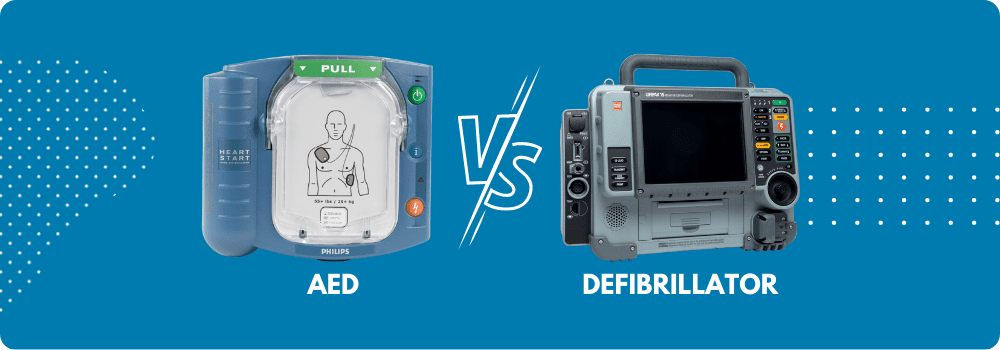- AHA Training Materials
By Course
By Item
By Year
- CPR Manikins
By Series
By Type
- CPR Training Accessories
By Brand
By Type
- AED Trainers
By Item
By Brand
- AEDS
- AED ACCESSORIES
- FIRST AID
- REQUEST A QUOTE
- SPECIALS

In the event of a cardiac emergency, no one wonders about the difference between an AED and a defibrillator. Both devices are used with a person is experiencing a serious heart problem called ventricular fibrillation or when the heart stops beating and the lower chambers begin to quiver. Both an AED and a defibrillator administer a targeted electrical shock to the heart, allowing it to resume a normal heartbeat. However, there are subtle differences between the two machines that come down to how they are used in emergency situations.
AED stands for Automated External Defibrillator. A sudden cardiac arrest will kill nine out of ten patients it affects if bystanders do not intervene. CPR is often the first line of defense when a person experiences sudden cardiac arrest, but when performed incorrectly does not have the desired effect. AEDs were developed to enable non-medical personnel to administer life-saving electrical shocks to the heart of a person experiencing a heart attack. These devices are equipped with electrodes, pictorial instructions, a monitor, and a beep that alerts the user as to when to administer the shock. In cases where a bystander is able to effectively use an AED, the patient’s likelihood of survival increases by 300 percent.
All defibrillators serve the same purpose. They are meant to administer an electrical shock to get the heart beating the way it should. While an AED is a type of defibrillator, it is by no means the only type. Internal and external manual defibrillators, semi-automated external defibrillators, implantable cardioverter defibrillator, and wearable cardiac defibrillators are used to treat different types of cardiac conditions in a hospital setting. Manual defibrillators have capabilities that automated models do not. From delivering pulses of electricity to the heart to stimulate contraction of the heart to converting arrhythmia to a normal heartbeat, manual defibrillators are designed for use by medical personnel who are trained to detect different heart problems and treat them appropriately. In some cases where an AED was first used to treat a person experiencing sudden cardiac arrest, a manual defibrillator is later used to treat a patient.
Implantable defibrillators and wearable cardiac defibrillators are designed to administer electrical shocks to the heart without user intervention. In cases where a patient experiences periodic arrhythmia (irregular heartbeat), these devices will help the heart come back into normal rhythm automatically. Regardless of the type of defibrillator used, it is no secret that these devices save lives. While it is tempting to sit and wait for emergency medical support, time is of the essence when it comes to cardiac arrest. For every minute the victim does not have a normal heartbeat, their chances of survival decrease by 10 percent. Even in the best of circumstances, an emergency medical response cannot respond as quickly as a bystander with access to an AED. As a result, AEDs are popping up in airports, shopping malls, sporting arenas, gyms, and schools across the country.
For more information on AEDs or to purchase a device for your home, office, school, or store, contact One Beat Medical!